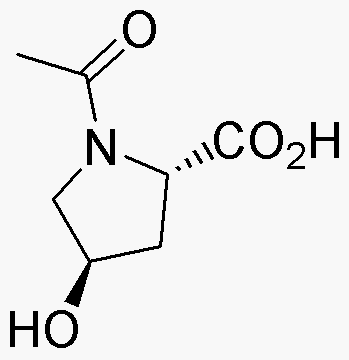Acetyl-L-trans-4-hydroxyproline is widely utilized in research focused on:
- Pharmaceutical Development: This compound is often used in the synthesis of peptides and proteins, playing a crucial role in drug formulation and development.
- Cosmetic Industry: Its properties make it an excellent ingredient in skincare products, promoting hydration and improving skin texture.
- Food Industry: Used as a food additive, it enhances flavor and texture in various food products, contributing to improved consumer experience.
- Biotechnology: Researchers utilize it in studies related to collagen synthesis, which is vital for understanding skin aging and developing anti-aging treatments.
- Research Applications: It serves as a valuable tool in academic and clinical research, particularly in studies involving amino acids and their derivatives.
General Information
Properties
Safety and Regulations
Applications
Acetyl-L-trans-4-hydroxyproline is widely utilized in research focused on:
- Pharmaceutical Development: This compound is often used in the synthesis of peptides and proteins, playing a crucial role in drug formulation and development.
- Cosmetic Industry: Its properties make it an excellent ingredient in skincare products, promoting hydration and improving skin texture.
- Food Industry: Used as a food additive, it enhances flavor and texture in various food products, contributing to improved consumer experience.
- Biotechnology: Researchers utilize it in studies related to collagen synthesis, which is vital for understanding skin aging and developing anti-aging treatments.
- Research Applications: It serves as a valuable tool in academic and clinical research, particularly in studies involving amino acids and their derivatives.
Documents
Safety Data Sheets (SDS)
The SDS provides comprehensive safety information on handling, storage, and disposal of the product.
Product Specification (PS)
The PS provides a comprehensive breakdown of the product’s properties, including chemical composition, physical state, purity, and storage requirements. It also details acceptable quality ranges and the product's intended applications.
Certificates of Analysis (COA)
Search for Certificates of Analysis (COA) by entering the products Lot Number. Lot and Batch Numbers can be found on a product’s label following the words ‘Lot’ or ‘Batch’.
*Catalog Number
*Lot Number
Certificates Of Origin (COO)
This COO confirms the country where the product was manufactured, and also details the materials and components used in it and whether it is derived from natural, synthetic, or other specific sources. This certificate may be required for customs, trade, and regulatory compliance.
*Catalog Number
*Lot Number
Safety Data Sheets (SDS)
The SDS provides comprehensive safety information on handling, storage, and disposal of the product.
DownloadProduct Specification (PS)
The PS provides a comprehensive breakdown of the product’s properties, including chemical composition, physical state, purity, and storage requirements. It also details acceptable quality ranges and the product's intended applications.
DownloadCertificates of Analysis (COA)
Search for Certificates of Analysis (COA) by entering the products Lot Number. Lot and Batch Numbers can be found on a product’s label following the words ‘Lot’ or ‘Batch’.
*Catalog Number
*Lot Number
Certificates Of Origin (COO)
This COO confirms the country where the product was manufactured, and also details the materials and components used in it and whether it is derived from natural, synthetic, or other specific sources. This certificate may be required for customs, trade, and regulatory compliance.


